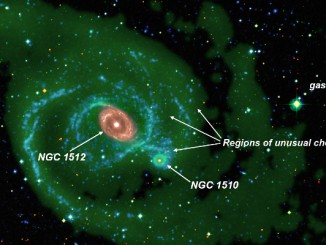
Many galaxies have an extremely bright core, or nucleus, powered by material falling toward a supermassive black hole. These so-called “active galactic nuclei” or AGN, are some of the brightest objects in the universe.
Astronomers classify AGN into two main types based on the properties of the light they emit. One type of AGN tends to be brighter than the other. The brightness is generally thought to depend on either or both of two factors: the AGN could be obscured by surrounding gas and dust, or it could be intrinsically dim because the rate of feeding of the supermassive black hole is low.
Some AGN have been observed to change once between these two types over the course of only 10 years, a blink of an eye in astronomical terms. However, the AGN associated with the galaxy Markarian 1018 stands out by changing type twice, from a faint to a bright AGN in the 1980s and then changing back to a faint AGN within the last five years. A handful of AGN have been observed to make this full-cycle change, but never before has one been studied in such detail. During the second change in type the Markarian 1018 AGN became eight times fainter in X-rays between 2010 and 2016.
After discovering the AGN’s fickle nature during a survey project using ESO’s Very Large Telescope (VLT), astronomers requested and received time to observe it with both NASA’s Chandra X-ray Observatory and the NASA/ESA Hubble Space Telescope.
Data from ground-based telescopes including the VLT allowed the researchers to rule out a scenario in which the increase in the brightness of the AGN was caused by the black hole disrupting and consuming a single star. The VLT data also cast doubt on the possibility that changes in obscuration by intervening gas cause changes in the brightness of the AGN.
However, the true mechanism responsible for the AGN’s surprising variation remained a mystery until Chandra and Hubble data was analysed. Chandra observations in 2010 and 2016 conclusively showed that obscuration by intervening gas was not responsible for the decline in brightness. Instead, models of the optical and ultraviolet light detected by Hubble, NASA’s Galaxy Evolution Explorer (GALEX) and the Sloan Digital Sky Survey in the bright and faint states showed that the AGN had faded because the black hole was being starved of infalling material. This starvation also explains the fading of the AGN in X-rays.
One possible explanation for this starvation is that the inflow of fuel is being disrupted. This disruption could be caused by interactions with a second supermassive black hole in the system. A black hole binary is possible as the galaxy is the product of a collision and merger between two large galaxies, each of which likely contained a supermassive black hole in its centre.
The list of observatories used in this finding also includes NASA’s Nuclear Spectroscopic Telescope Array (NuSTAR) mission and the Swift Gamma-Ray Burst spacecraft.



